-
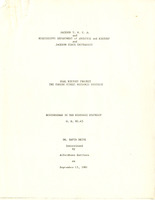 Dr. David White interviewed by Alferdteen Harrison, Transcript.
Dr. David White interviewed by Alferdteen Harrison, Transcript. Dr. David White was the first Black optometrist in the state of Mississippi when he moved onto Farish Street in 1951. He talks about Farish Street before and after integration: Black businesses became less prosperous after integration as some Black customers went to white owned businesses. He also talks about his involvement with the NAACP.
-
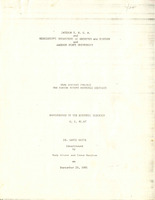 Dr. David White interviewed by Mary Street and Irene Hampton, Transcript.
Dr. David White interviewed by Mary Street and Irene Hampton, Transcript. Dr. David White was the first Black optometrist in the state of Mississippi when he moved onto Farish Street in 1951. He talks about how his first White customers came during the Civil Rights Movement as there was an active meeting place for activists above his business.
-
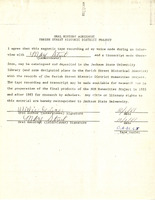 Willie Devine interviewed by Mary Street, Transcript.
Willie Devine interviewed by Mary Street, Transcript. Willie Devine lived many years in the Farish Street District. He talks about growing up and the activities he did, including swimming at the newly built pool and the music and dancing in the district. He recounts the harassment of young Black children by White people on the streets when he was in grade school.
-
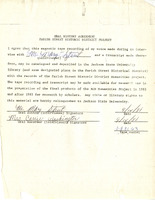 Carrie Washington interviewed by Mary Street, Transcript.
Carrie Washington interviewed by Mary Street, Transcript. Carrie Washington was born in 1895 and moved to the Farish Street District in 1933 and has lived there since. Ms. Washington talks about her time in the district and her experiences working in the homes of White people. She also talks about businesses and buildings in the district and the flood of 1927.
-
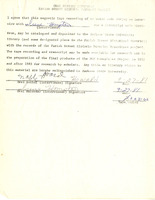 Mabel E. Howard interviewed by Irene Hampton, Transcript.
Mabel E. Howard interviewed by Irene Hampton, Transcript. Mabel E. Howard was born in the Farish Street District in 1911 and worked at several businesses in the district. She talks about her time living in the district, the schools she attended, and being baptized at Christ Temple Church, and her favorite places to eat in the district. The transcript is edited with handwritten and typed notes.
-
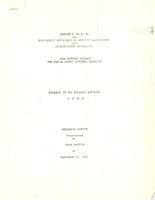 Gwendolyn Hampton interviewed by Irene Hampton: "Resident in the Historic District," Transcript.
Gwendolyn Hampton interviewed by Irene Hampton: "Resident in the Historic District," Transcript. Gwendolyn Hampton was born in the Farish Street District in 1953 and attended several schools in the area, including Smith Robertson School. Mrs. Hampton reflects on changes in many areas in the district, including the disciplining of neighborhood children and the attitude of "country folk" who came to Farish Street to shop.
-
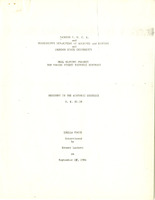 Idella Foot interviewed by Ernest Luckett: "Resident in the Historic District," Transcript.
Idella Foot interviewed by Ernest Luckett: "Resident in the Historic District," Transcript. Idella Foot moved to the Farish Street District in 1931 and lived her entire life on multiple different streets in the district. Ms. Foote discusses her children and her church affiliation. She also talks about the changes the district has undergone over the decades, saying that the district underwent big changes after the older generation died.
-
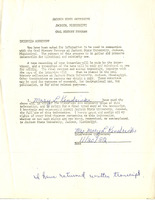 Mary L. Smith Kendricks interviewed by Cheryl A. Payne, Transcript.
Mary L. Smith Kendricks interviewed by Cheryl A. Payne, Transcript. Mary L. Smith Kendricks moved to the Farish Street District in 1929 and worked at several businesses in the district. She recounts her experiences as a child during the Great Depression and then her experiences with entertainment in the district in the 1940s and the present state of the district. Transcript is heavily edited with handwritten notes.
-
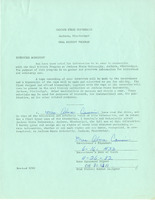 Alma Cousins interviewed by Cheryl Payne, Transcript.
Alma Cousins interviewed by Cheryl Payne, Transcript. Alma Cousins moved to the Farish Street District in 1953 and previously owned a restaurant in the neighborhood. Ms. Cousins recounts what the district was like back then compared to the present. She talks about businesses and restaurants in the district; the effects of White people moving into the area; and several Black lawyers in the district.
 Dr. David White interviewed by Alferdteen Harrison, Transcript. Dr. David White was the first Black optometrist in the state of Mississippi when he moved onto Farish Street in 1951. He talks about Farish Street before and after integration: Black businesses became less prosperous after integration as some Black customers went to white owned businesses. He also talks about his involvement with the NAACP.
Dr. David White interviewed by Alferdteen Harrison, Transcript. Dr. David White was the first Black optometrist in the state of Mississippi when he moved onto Farish Street in 1951. He talks about Farish Street before and after integration: Black businesses became less prosperous after integration as some Black customers went to white owned businesses. He also talks about his involvement with the NAACP. Dr. David White interviewed by Mary Street and Irene Hampton, Transcript. Dr. David White was the first Black optometrist in the state of Mississippi when he moved onto Farish Street in 1951. He talks about how his first White customers came during the Civil Rights Movement as there was an active meeting place for activists above his business.
Dr. David White interviewed by Mary Street and Irene Hampton, Transcript. Dr. David White was the first Black optometrist in the state of Mississippi when he moved onto Farish Street in 1951. He talks about how his first White customers came during the Civil Rights Movement as there was an active meeting place for activists above his business. Willie Devine interviewed by Mary Street, Transcript. Willie Devine lived many years in the Farish Street District. He talks about growing up and the activities he did, including swimming at the newly built pool and the music and dancing in the district. He recounts the harassment of young Black children by White people on the streets when he was in grade school.
Willie Devine interviewed by Mary Street, Transcript. Willie Devine lived many years in the Farish Street District. He talks about growing up and the activities he did, including swimming at the newly built pool and the music and dancing in the district. He recounts the harassment of young Black children by White people on the streets when he was in grade school. Carrie Washington interviewed by Mary Street, Transcript. Carrie Washington was born in 1895 and moved to the Farish Street District in 1933 and has lived there since. Ms. Washington talks about her time in the district and her experiences working in the homes of White people. She also talks about businesses and buildings in the district and the flood of 1927.
Carrie Washington interviewed by Mary Street, Transcript. Carrie Washington was born in 1895 and moved to the Farish Street District in 1933 and has lived there since. Ms. Washington talks about her time in the district and her experiences working in the homes of White people. She also talks about businesses and buildings in the district and the flood of 1927. Mabel E. Howard interviewed by Irene Hampton, Transcript. Mabel E. Howard was born in the Farish Street District in 1911 and worked at several businesses in the district. She talks about her time living in the district, the schools she attended, and being baptized at Christ Temple Church, and her favorite places to eat in the district. The transcript is edited with handwritten and typed notes.
Mabel E. Howard interviewed by Irene Hampton, Transcript. Mabel E. Howard was born in the Farish Street District in 1911 and worked at several businesses in the district. She talks about her time living in the district, the schools she attended, and being baptized at Christ Temple Church, and her favorite places to eat in the district. The transcript is edited with handwritten and typed notes. Gwendolyn Hampton interviewed by Irene Hampton: "Resident in the Historic District," Transcript. Gwendolyn Hampton was born in the Farish Street District in 1953 and attended several schools in the area, including Smith Robertson School. Mrs. Hampton reflects on changes in many areas in the district, including the disciplining of neighborhood children and the attitude of "country folk" who came to Farish Street to shop.
Gwendolyn Hampton interviewed by Irene Hampton: "Resident in the Historic District," Transcript. Gwendolyn Hampton was born in the Farish Street District in 1953 and attended several schools in the area, including Smith Robertson School. Mrs. Hampton reflects on changes in many areas in the district, including the disciplining of neighborhood children and the attitude of "country folk" who came to Farish Street to shop. Idella Foot interviewed by Ernest Luckett: "Resident in the Historic District," Transcript. Idella Foot moved to the Farish Street District in 1931 and lived her entire life on multiple different streets in the district. Ms. Foote discusses her children and her church affiliation. She also talks about the changes the district has undergone over the decades, saying that the district underwent big changes after the older generation died.
Idella Foot interviewed by Ernest Luckett: "Resident in the Historic District," Transcript. Idella Foot moved to the Farish Street District in 1931 and lived her entire life on multiple different streets in the district. Ms. Foote discusses her children and her church affiliation. She also talks about the changes the district has undergone over the decades, saying that the district underwent big changes after the older generation died. Mary L. Smith Kendricks interviewed by Cheryl A. Payne, Transcript. Mary L. Smith Kendricks moved to the Farish Street District in 1929 and worked at several businesses in the district. She recounts her experiences as a child during the Great Depression and then her experiences with entertainment in the district in the 1940s and the present state of the district. Transcript is heavily edited with handwritten notes.
Mary L. Smith Kendricks interviewed by Cheryl A. Payne, Transcript. Mary L. Smith Kendricks moved to the Farish Street District in 1929 and worked at several businesses in the district. She recounts her experiences as a child during the Great Depression and then her experiences with entertainment in the district in the 1940s and the present state of the district. Transcript is heavily edited with handwritten notes. Alma Cousins interviewed by Cheryl Payne, Transcript. Alma Cousins moved to the Farish Street District in 1953 and previously owned a restaurant in the neighborhood. Ms. Cousins recounts what the district was like back then compared to the present. She talks about businesses and restaurants in the district; the effects of White people moving into the area; and several Black lawyers in the district.
Alma Cousins interviewed by Cheryl Payne, Transcript. Alma Cousins moved to the Farish Street District in 1953 and previously owned a restaurant in the neighborhood. Ms. Cousins recounts what the district was like back then compared to the present. She talks about businesses and restaurants in the district; the effects of White people moving into the area; and several Black lawyers in the district.